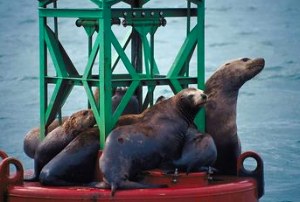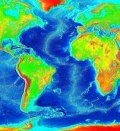 Recently, an innocuous-seeming press release was released by German astronomers announcing that they had found two of the most complex molecules ever in space – n-propyl cyanide, more commonly known to chemists as butyronitrile, and ethyl formate. Now, butyronitrile is a nasty poison with a characteristic odour and I’m sure you’d get a whiff of bitter almonds as you lay dying should you breathe it in too deep or get a mouthful of the stuff. Ethyl formate is altogether different.
Recently, an innocuous-seeming press release was released by German astronomers announcing that they had found two of the most complex molecules ever in space – n-propyl cyanide, more commonly known to chemists as butyronitrile, and ethyl formate. Now, butyronitrile is a nasty poison with a characteristic odour and I’m sure you’d get a whiff of bitter almonds as you lay dying should you breathe it in too deep or get a mouthful of the stuff. Ethyl formate is altogether different.
Ethyl formate, The Guardian’s science correspondent Ian Sample found out (I think already knew) is the fragrant ester molecule that gives raspberries their distinct flavour. It also smells vaguely of rum. Having latched on to this fact, Sample went to town on his galactic press release suggesting, in a Pythonesque manner, that your galaxy smells of raspberries.
It was a great hook for his popular science article in the paper, of course, and the idea was subsequently picked up by other outlets that had initially missed the raspberry flavour additive. With my SpectroscopyNOW deadline looming, I reasoned that the research was valid enough, ignoring the raspberries, for the news channel and set about explaining the ins and outs of the discovery and its relevance.
If complex molecules such as ethyl formate and butyronitrile can be found in space then perhaps the building blocks of proteins, amino acids, might also be present, which could lend evidence to space as being the seeding ground for the precursors to life on earth and perhaps extraterrestrial life too.
I contacted the leader of the astronomical team that had made this startling discovery to find out more details about the research. Arnaud Belloche of the Max Planck Institute for Radio Astronomy (MPIfR) in Bonn, Germany, was unsurprisingly quick to point out that the raspberry connection was essentially a journalistic invention of The Guardian and has no bearing on the research at all.
“We did not report on the flavour of raspberry or the smell of rum,” he told me, “For us, astronomers, it is unimportant. What is important is that these two molecules are quite complex compared to the other molecules discovered in space, and that their discovery suggests that even more complex molecules are likely present in the interstellar medium.”
He did, however, concede that the reference to raspberries and rum makes the story more interesting for the lay public. “It is fine to mention it, but it should be made clear that it is astronomically irrelevant.” Of course, that much should be immediately obvious to most readers of SpectroscopyNOW.
It does raise an interesting point about science journalism. Is it stretching the truth, or dumbing down, too much to mention that the molecules found in outer space have a link with the flavour of raspberries? How far should we go to make rather technical and esoteric science appeal to a lay audience? Surely, it would have been enough that these complex molecules were found in space and may have a bearing on the origins of life on earth.
Perhaps not. A press release blankly referring to two chemicals with names obscure to non-chemists would usually have little impact. It was picked up by some outlets. However, it was only once Ian Sample had made the raspberry connection and used the Monty Python Holy Grail insult allusion (if your galaxy doesn’t smell of raspberries then your mother certainly still smells of elderberries) that more of the wider media jumped on to the idea of a galaxy smelling faintly of raspberries and rum and took it mainstream.
Indeed, we have a control to test this, because the same team use the same data lasts year to reveal that the same galactic gas cloud also contains aminoacetonitrile. This molecule is a
likely chemical precursor of the amino acid glycine, which has perhaps a much greater bearing on the origins of life than the raspberry flavouring, but unfortunately has none of the fruity allusions.
Which headline would grab you?
Scientists Spot Amino Acetonitrile in the Middle of Milky Way
or
Make That A Raspberry Pan Galactic Gargle Blaster
You can read my full write-up complete with overblown flavouring-enriched title in the May 1 issue of SpectroscopyNOW.
Finally, I asked Belloche for his predictions of when we might discover amino acids in space and get a true feeling for the notion of cosmic dust seeding the primordial earth.
“I guess we’ll have to wait many years…” he told me, “A simple estimate we did in
our publication on aminoacetonitrile (Belloche et al. 2008, A&A, 482, 179)
suggests that the abundance of glycine, if present in the interstellar
medium, is well below the best upper limits derived so far, by maybe one
or two orders of magnitude, so it will be hard (but not impossible!) to
find it.”
His prediction doesn’t leave a bitter taste in the mouth, but nor does it come up tasting of raspberries.
 US scientists have identified a new strain of influenza in New England harbor seals – H3N8. They say the strain, presumably made the species leap from birds, might now be a reservoir for an emergent human flu virus.
US scientists have identified a new strain of influenza in New England harbor seals – H3N8. They say the strain, presumably made the species leap from birds, might now be a reservoir for an emergent human flu virus. The Alchemist this week learns how fluorine chemistry is blooming, how to melt proteins, and how cholesterol is all about the good, the bad, and the oxy. Also this week, a technique borrowed from organic LED fabrication could lead to a new way to manufacture tiny inorganic LEDs for next generation displays, while a conductive flip has been observed with clusters of atoms close to absolute zero. Finally, the American Chemical Society announces this years previously unsung chemical heroes from across the industry.
The Alchemist this week learns how fluorine chemistry is blooming, how to melt proteins, and how cholesterol is all about the good, the bad, and the oxy. Also this week, a technique borrowed from organic LED fabrication could lead to a new way to manufacture tiny inorganic LEDs for next generation displays, while a conductive flip has been observed with clusters of atoms close to absolute zero. Finally, the American Chemical Society announces this years previously unsung chemical heroes from across the industry.
 Recently, an innocuous-seeming press release was released by German astronomers announcing that they had found two of the most complex molecules ever in space – n-propyl cyanide, more commonly known to chemists as butyronitrile, and ethyl formate. Now, butyronitrile is a nasty poison with a characteristic odour and I’m sure you’d get a whiff of bitter almonds as you lay dying should you breathe it in too deep or get a mouthful of the stuff. Ethyl formate is altogether different.
Recently, an innocuous-seeming press release was released by German astronomers announcing that they had found two of the most complex molecules ever in space – n-propyl cyanide, more commonly known to chemists as butyronitrile, and ethyl formate. Now, butyronitrile is a nasty poison with a characteristic odour and I’m sure you’d get a whiff of bitter almonds as you lay dying should you breathe it in too deep or get a mouthful of the stuff. Ethyl formate is altogether different. This week, The Alchemist is digging in the dirt to find out about the carbon cycle and climate change, taking his
This week, The Alchemist is digging in the dirt to find out about the carbon cycle and climate change, taking his  If you ever thought genetics was only about disease, then check out the popular SNPs list on
If you ever thought genetics was only about disease, then check out the popular SNPs list on